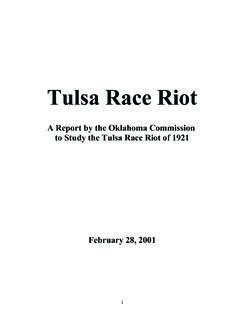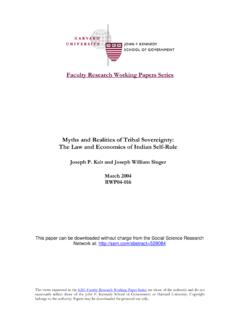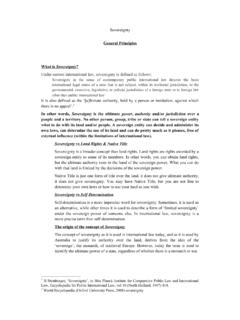Transcription of Tribal Sovereignty Overview Definition
1 OHC EDU | 1 May 2020 Tribal Sovereignty Overview Definition Tribal Sovereignty is the concept that individual tribes, rather than the state or federal government, possess the authority to make decisions regarding anything related to the tribe as a whole or its members. Important Concepts Tribes possess Sovereignty by fundamental right first; it is not granted by any other authority. Prior to European settlement, tribes freely and easily exercised their Sovereignty . The colonists and early US government recognized Tribal Sovereignty by entering into treaties with tribes. The Constitution s Supremacy Clause guarantees treaties concluded and implemented by the US government as the supreme law of the land. Federal laws and treaties take precedence over state law. Arguments to limit Sovereignty developed to support settlers demand for land. Although there were clear constitutional requirements involved, the people and governments in the United States violated the fundamental rights of the Five Tribes when implementing the Indian Removal Act of 1830.
2 Superseding policies of the federal government consistently and increasingly damaged Tribal Sovereignty . Until 1968, governments brutally suppressed Tribal efforts to express Sovereignty . An important organization arguing for governmental recognition of Tribal Sovereignty was the American Indian Movement. The refusal to recognize Tribal Sovereignty is intricately connected with the dispossession of Tribal land. Historical Context During the colonial and early United States periods, tribes possessed significant strength in comparison to the emerging republic. Other European powers maintained an interest in the continent and in fostering productive relations with Tribal groups. The multilateral nature of power on the continent and the relative balance of power resulted in the colonies and the US government treating tribes as equal, independent nations with complete authority to conduct their affairs, make war, and enter into agreements. As such, the supremacy of treaties concluded with tribes is explicitly mentioned in the Constitution, and Congress is given exclusive authority to handle American Indian affairs.
3 With the acquisition of the Louisiana Purchase and Napoleonic hostilities consuming European attention away from the New World, the balance of power swung in favor of the United States and away from individual tribes. Tecumseh s effort to create a Pan-Indian state attempted to solve this problem, but it failed. As a result, the many smaller tribes confronted a powerful United States that was intent on expanding t o provide its white residents the opportunity to extract wealth from the earth through mining and agriculture intended for commercial use. OHC EDU | 2 May 2020 Rapidly, many influential individuals, such as Thomas Jefferson, argued that the tribes faced inevitable extinction and should be removed to a distant territory so that they could move gradually toward assimilation. They further argued that the land left behind by removed tribes would finally be put to productive use by new settlers. In 1829 t he discovery of gold in Cherokee territory in the southeastern United States provoked aggressive actions against the Cherokee by the state of Georgia.
4 The Cherokee appealed to the federal government to honor its obligations; however, the controversy provided a convenient pretext to promote the claim that the Indians needed to be sent far away. In 1830 the Indian Removal Act passed Congress and was enthusiastically signed by Andrew Jackson. As negotiations proceeded to remove the Five Tribes to Indian Territory, court cases culminated in the Supreme Court that would establish, while curtailing, the Sovereignty rights of the tribes. In these cases, the Supreme Court declared the status of the tribes as domestic dependent nations with the federal government serving as a guardian to the tribes (Cherokee Nation v. Georgia, 1831). The next year, in another case, the Supreme Court found that even with this unequal relationship between tribes and the federal government, the tribes remained sovereign (Worcester v. Georgia, 1832). The involuntary removals of Tribal members violated the Constitution. As military forts and infrastructure expanded throughout the interior and settlers followed, the United States continued the policy of relocation and concentration, securing land cessions and agreement to relocate through hundreds of treaties with tribes.
5 Although the treaty process suggests the US respected Tribal Sovereignty , the method by which many treaties agreed upon ignored Tribal Sovereignty . Tactics included allowing small, hand-picked parties to negotiate and sign treaties without consulting the larger Tribal leadership structure, ignoring treaty obligations, or illegally taking land (Fort Laramie Treaty and the Black Hills). The broad spectrum of assistance provided to the Confederacy by many tribes ( even though some of that assistance was coerced and many Tribal members supported and fought for the Union) provided the United States government the opportunity to abrogate early treaties. New treaties concluded during Reconstruction stripped the Five Tribes of land and made other demands that deeply violated Tribal Sovereignty , such as requiring that those formerly enslaved by Tribal members be given Tribal rights, and allowing right-of-way rights for railroads in their land. Shortly after the conclusion of the Reconstruction treaties, Congress passed legislation that prevented any further treaties with Indian tribes.
6 The decade of 1870 to 1879 saw a significant shift regarding the perception of tribes and their position, resulting in the rejection of the legitimacy of Tribal Sovereignty . The United States government passed and implemented the General Allotment Act (Dawes Act), which pursued the destruction of Tribal governance and the assimilation of individual Tribal members. Officials forcibly removed Indian children from parents, sending them to boarding schools designed to eradicate any vestige of Tribal identity, further eroding the capacity of tribes to assert their Sovereignty . Very little changed until the 1935 passage of the Indian Reorganization Act (IRA), which attempted to address the challenges created by Dawes. This law prohibited the further allotment of Tribal land and the dispossession of Tribal land without the consent of the tribe. The IRA also acknowledged Tribal Sovereignty by recognizing Tribal governments and returning the power to manage Tribal assets to the tribes.
7 OHC EDU | 3 May 2020 This policy approach carved out by the IRA lasted a mere twenty years, and policy commonly referred to as termination replaced it in 1953. The federal government returned to its earlier goal of assimilating individual Tribal members and the destruction of Tribal governance. Laws passed under this policy sought to relocate many Indians to urban areas, disrupting their connection to their tribe and allowing states (previously prevented from policing on Tribal land) the authority to enforce criminal law and prosecute Indian defendants through the passage of Public Law 280. The federal government sought to terminate its ongoing responsibility to the tribes and moved to disband tribes and reservations. The 1960s introduced a new awareness of efforts for social justice and civil rights. This included the emergence of militant Indian rights organizations such as the American Indian Movement (AIM). One of AIM s central arguments demanded the restoration of Tribal Sovereignty rights due to the tribes.
8 Headline-grabbing protests at Alcatraz and Wounded Knee allowed the organization the opportunity to educate both government officials and bystanders on the government s record of violating Tribal Sovereignty . This national discussion produced both Tribal leaders and government allies motivated to develop a new structure acknowledging and protecting Tribal Sovereignty . Today, Tribal Sovereignty remains challenging to protect as the Supreme Court, in deciding cases about Sovereignty , frequently finds against the Tribal position. Tribal Sovereignty is, at least, included in the discussion about the relationship between the tribes and other government entities. Passage of several laws, including the Indian Child Welfare Act and the Indian Gaming Regulatory Act, signifies a greater recognition of Tribal Sovereignty . OHC EDU | 4 May 2020 Contemporary Connections Who Owns Oklahoma? What Sovereignty Means for America s Indian Tribes Why the Sioux Are Refusing $ Billion The Thirty Meter Telescope Moves Ahead on Mauna Kea Labor Concerns Trump Tribal Sovereignty in Congress Can Congress Void A Tribal Treaty Without Telling Anyone?
9 Lighting the West, Dividing the Tribe Disappearing Indians: Who Decides Who s In and Who s Out? Who Should Get to Adopt Native American Children? For Native Americans, Land is More Than Just the Ground Beneath Their Feet 2 Years After Standing Rock Protests, Tensions Remain Bus Oil Business Booms Resources Native Voice One Indian Country Today What is Tribal Sovereignty ? Historical Tribal Sovereignty & Relations Using Primary Source Documents to Understand Tribal Sovereignty Analyzing Primary Source Documents to Understand US Expansionism and 19th Century US-Indian Relations BESE Explains Tribal Sovereignty DocsTeach: American Indians Indian Pride: Treaties and Sovereignty , PBS Lesson Plan Tribal Government, iCivics Lesson Plan






